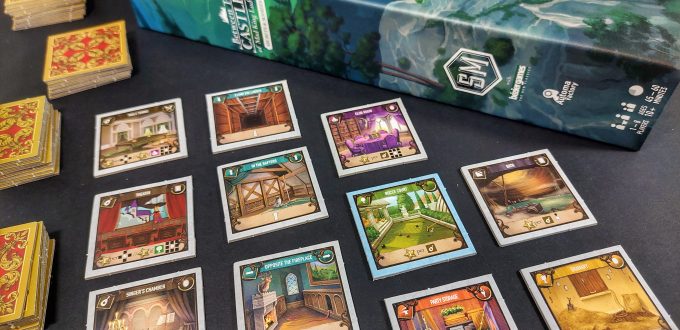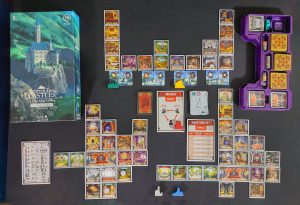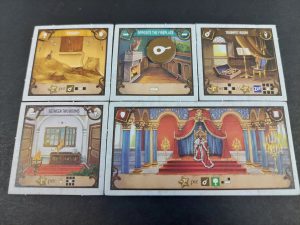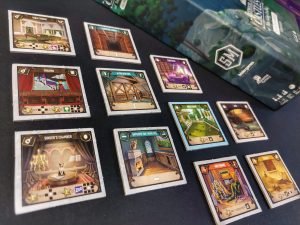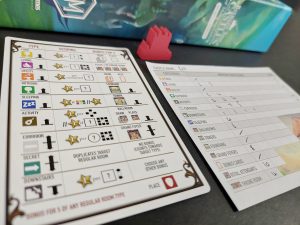Bury Board Games has been invited to the party in Stonemaier Games’ latest expansion to Between Two Castles of Mad King Ludwig – Secrets & Soirees!
BY BURY BOARD GAMES
Publisher: Stonemaier Games (with Bezier Games)
Designer: Ben Rosset and Matthew O’Malley
Artist: Agnieszka Dąbrowiecka, Laura Bevon, Bartłomiej Kordowski
Release date: 2021
Player Count: 1-8 Players
Time: 45-60 minutes
Age: 10+
Score: 7/10
Mad King Ludwig is back! And this time he’s throwing a party for the neighbours, and you’re invited. There’s all manner of Activity rooms, ballrooms, and oh, what’s this? Is that a secret panel behind the curtain? That’s right, as well as wanting you to design him a madcap manor, Ludwig also wants secret rooms inside his castle. Secrets & Soirees is an expansion for Between Two Castles of Mad King Ludwig, by Ben Rosset and Matthew O’Malley. In fact, I reviewed the base game right here on Favourite Foe (click here to read more!).
Recap: What’s Between Two Castles Of Mad King Ludwig About, Again?
Between Two Castles of Mad King Ludwig is a tile-drafting, tile-placement game. It’s a love-child between Bézier Games’ The Castles of Mad King Ludwig, and Stonemaier’s Between Two Cities. It takes the ‘let’s build a wacky, wonderful castle out of tiles’ from Ludwig. But the Between Two Cities twist is what makes it so delightful and fascinating.
This is a semi-cooperative affair. Players each have a hand of square tiles, and you draft two per turn. Only, you’re not building your own castle. You and your neighbour build one between you. You play one of those two tiles into each castle. So in a three player game, for example, Archie builds a castle with Bernadette. But Archie’s also building another castle with Catherine. Meanwhile, Bernadette and Catherine also build a castle, between them. The catch is, at the end of the game, you score the lowest of your two castles. It means you can’t afford to drop the ball on contributing towards either of them…
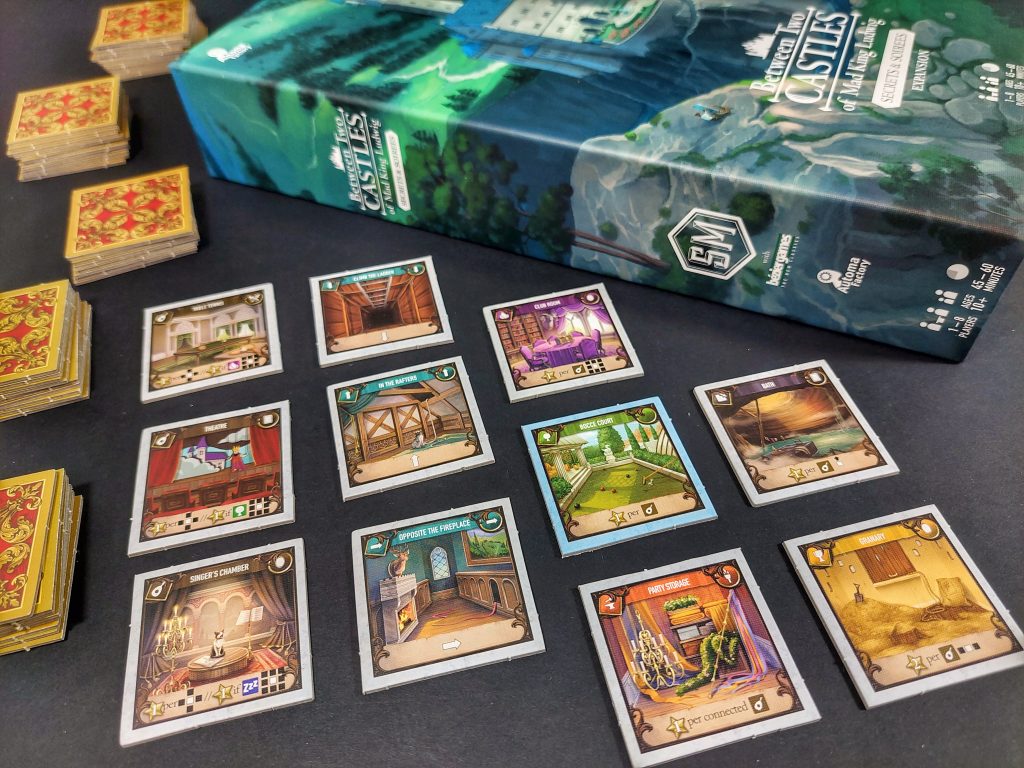
So What’s New?
There’s a decent amount of new content in the Secrets and Soirees expansion. It has an extra Throne Room, so can now cater for an eighth player to join in the fun. There’s two new room types – 24 Activity Rooms, and 16 Secret Rooms. The Secret Rooms also come with 48 regular room-type tokens (six of each). 16 Ballroom Tiles – a new Specialty Room – accompany the Activity Rooms. There’s also 21 new regular room tiles (spanning the seven original varieties of rooms). Eight new orange bonus cards enter the fray, some of which score in accordance to the new room tiles.
Eight replacement Player Aids come included. They’re vital for explaining the new tiles. There’s an updated score pad to compensate for the new room types. Secrets & Soirees also comes with a solo mode, a two-player only option, and The King’s Favour. The latter takes Between Two Castles… in a rather different direction. Is it a good direction, though?
A Singer’s Chamber Next To A Sleeping Room? Even Ludwig’s Not That Mad
Let’s break down those additions, starting with the Activity Rooms. The structure of the game doesn’t change – you still start with a hand of nine random tiles, drafting two. Activity Rooms are square tiles, the same size as the other room tiles, with the same tile-back. You’ll shuffle these, alongside the Secret Rooms, plus the 21 other new regular room tiles, into the stacks of base-game tiles. (These 21 tiles all feature a range of Activity Room-related facets, for scaling.)
Activity Rooms act as chambers where Ludwig wants to entertain his guests. They must sit at ground level or above. They score (up to four) points for having tiles adjacent to it – one point per tile. There’s a catch, though. They score a paltry single point, total, if they have a particular room type (stated on the tile) surrounding any of the nine adjacencies around it. Think the monastery in Carcassonne – but a rather picky one! (One Entertainment Room, such as Singer’s Chamber, doesn’t want to be close to a Sleeping Room. Makes sense, right? How is one supposed to catch some zzzs if someone’s warbling next door?) You can definitely shoot yourself in the foot with this room type if you’re not careful.
Place three Activity Rooms in a castle, and you get a bonus: a Ballroom. This is a Specialty Room (with the burgundy banner). You get to draw three Ballrooms, and pick one of them to place in your castle. It scores you 1 point per printed room type on it, that are present in both castles next-door to you. This makes it quite the passive interactive leech of a tile! You can sit back and let your neighbours help it generate points! And don’t forget, you yourself contribute to one of those neighbouring castles. How very convenient…
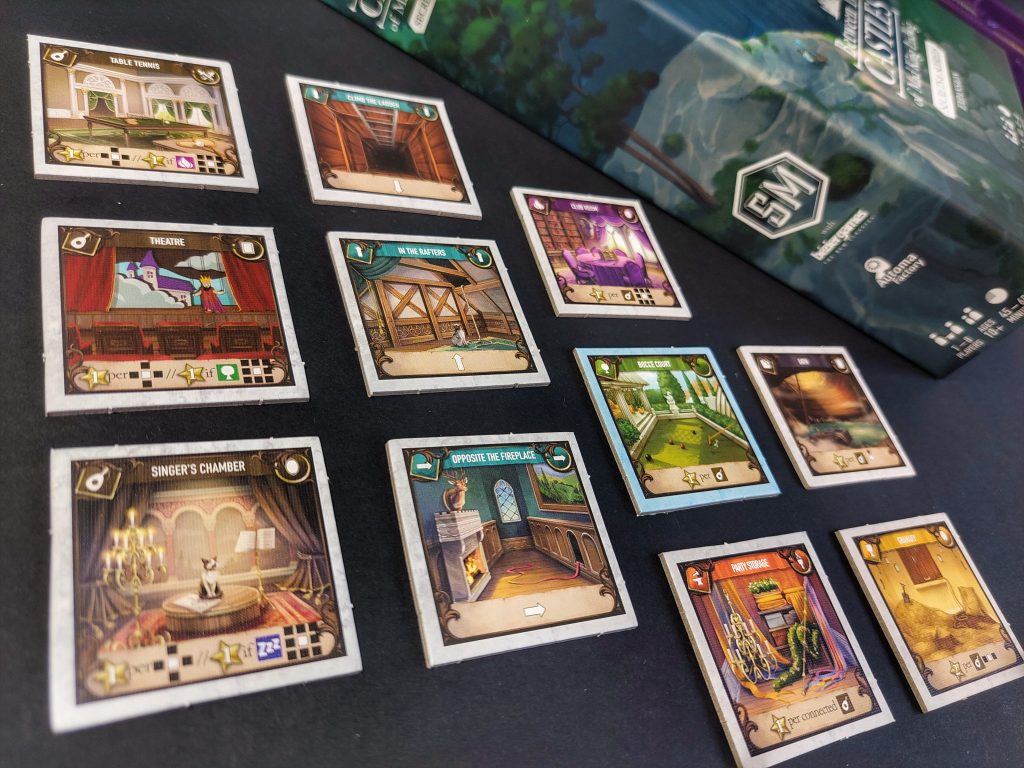
Keep It Secret, Keep It Safe
The Secret Rooms are both simplistic, and genius at the same time. They represent mysterious entries and passageways within the castle, leading to other rooms. Secret Rooms don’t have a set points value, as such. Instead, they’re more akin to a mirror. These tiles have an arrow on them, and they copy the tile they sit next to, in accordance to that arrow. This means copied for end-game scoring, the wall hanging, and it becomes that tile type, too. For the latter, it counts as being the third or fifth room type of a kind, thus triggering a bonus.
You place a corresponding token on top of the Secret Room, to remind you of what room type it now represents. This is handy for an at-a-glance view of your layout. Secret Rooms, when chosen with wisdom, can net you a decent score. You’re doubling the value of a room of your choice, which is a great decision to have! They can not copy Specialty Rooms, thought. Secret Rooms also don’t have their own bonus for playing three/five of a kind. Instead, they reward the bonus of whatever room they’re mimicking.
With both of these room tiles as extra ways to score, you might find yourself scoring higher here, compared to the base game. (Especially since the Sleeping Rooms score the same; you need need six – out of seven, now – different rooms for those Sleeping Rooms to be worth 4VP each. With extra room type added in, it felt easier to accomplish, versus getting a specific six out of six.)
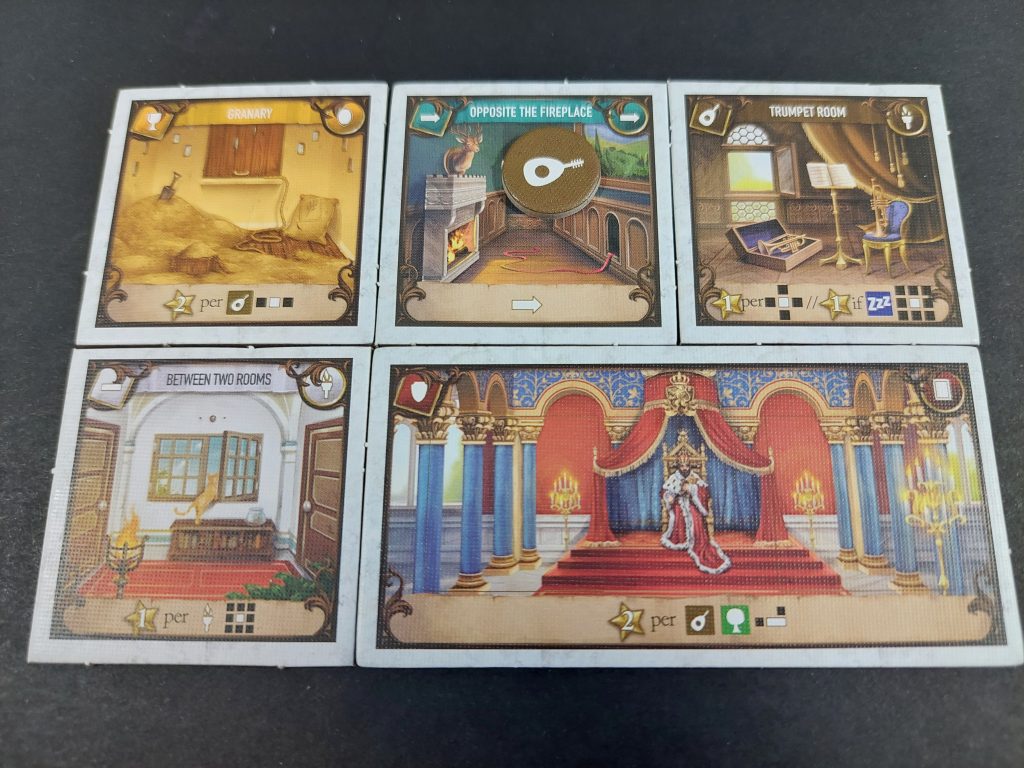
The Mad King’s Demand
Secrets & Soirees also provides a variant called The Mad King’s Demand. This removes the whole ‘Between’ aspect. Here, players only have their own castle to worry about, which you alone will score at the end. Players again draft two tiles per round. The difference here is that they keep one tile for themselves, and give the other tile to their neighbour. (So they’ll receive a tile from the player on their right each round.) Then you have to place both tiles – the one you picked, plus the one you ‘demanded’ off your neighbour.
This introduces a different dynamic that the game off to a tangent. In the regular game, it’s always in your best interests to pick the best two tiles from your hand. You want to benefit both castles. But in this mode, it encourages a kind of reverse hate-drafting. You end up trying to give your opponent the worst possible tile from your hand; one that doesn’t help them at all! (This could be a tile that doesn’t sync with their Activity Room, for example, as I mentioned earlier.)
This mode reverts back to a more traditional drafting sense. You’re playing to help yourself, alone. To me, the mechanism that makes Between Two Castles… tick is the fact castles sit between players. That semi-cooperative agenda made it stand out among a crowd of drafting games. Some players might prefer this mode, if they desire a pure, competitive experience. But this feels akin to stroking a cat’s fur the wrong way, though. This variant ignores its forefather’s roots. Taking the ‘Between’ philosophy out goes against what made Between Two Castles… so fascinating for me.
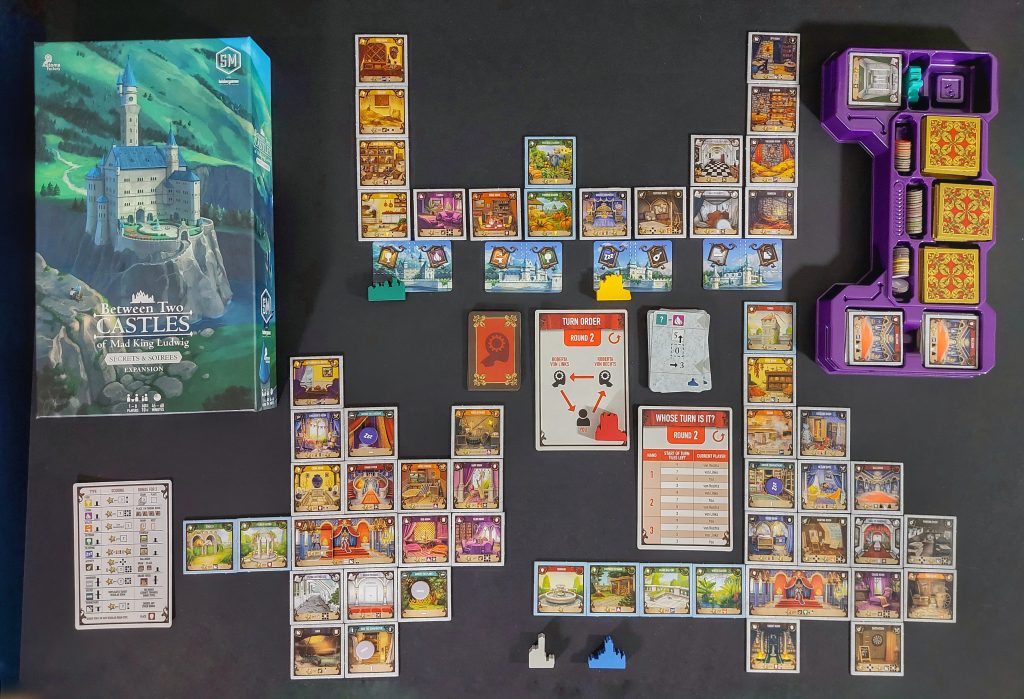
How Does This Work, Solo?
Secrets & Soirees also provides a solo mode. It uses a form of Stonemaier’s Automa system, a separate deck of cards that represent a bot player. The standard Automa system mimics a three-player game, with you playing with/against two bots. It’s designed by Morten Monrad Pedersen, whom also created the Automa for Viticulture. It allows you to contribute towards the two castles that sit between you and the bots. Meanwhile, the castle between the two bots gets built in a different manner…
You select nine random tiles, as per usual. But you sit all of them face-up in a row, leaving space to the left and right of you for two castles, with starting Throne Rooms. Before the bots’ turn, you place two of the spare wooden castle markers above two of the nine Room Tiles. These represent Tiles that you think would be a good fit for the castle sitting between you and the bot. Then you draw the top Automa card.
On it will be a series of requirements/filters that dictate which tile the bot drafts for itself, among those face-up tiles. It then places this tile in ‘Roberg’, but not in the traditional Between Two Castles… way. Instead, it stacks room tiles in columns by room type. Then, you check the bottom of the card. On it will be one of the two wooden castles, which you used for marking two of the tiles in the draw. The bot picks this tile to add to the castle between you. (If that tile isn’t available – because the bot picked it for itself – then it selects the tile you marked with the other signal castle.)
You don’t add any tiles from your own ‘hand’ here; you don’t have a hand of tiles, per se. It’s quite an unfamiliar experience. Then you repeat the process, marking two (of the seven remaining) tiles you think would be a good fit for the other castle. Another bot card gets revealed, and the bot drafts two tiles. After this, now it’s your turn to pick two tiles from the public display; one to the left and one to the right. There will, at some point, be only one tile left among the nine, which you discard. Then you place down another stack of nine tiles, and go again.
You end up going through six stacks of nine tiles, like you would in a regular game. You add up the scores of your two castles as per usual, taking the lower of the two. You then compare this to the value of the castle between the two bots. This scores differently to the norm. It earns points depending on the size of the columns of same room types it drafted, added to a flat base score. You can adjust the difficulty, by increasing the base score. You also give the bot’s castle extra tiles as a head start.
It’s a decent solo experience, with regards to mirroring the nature in which you build two castles. The way in which the bots draft tiles though isn’t as satisfying as playing this with fellow human players, though. I see this solo mode as more of a pleasant addition to the ‘Between’ experience, rather than an essential one. It’s interesting, but not paramount. There are other games I’d opt to play solo over this. It does at least have a range of difficulties, so you can up the ante.

That GameTrayz Insert, Though
This expansion comes with a purple GameTrayz plastic molded insert. It’s in the same style as the yellow/red ones in the base game. It can fit all the new tiles in it, alongside the Secret Room tokens and the Ballrooms. If you want to play this with the Between Two Castles… base game, you’ll need to shuffle all the room tiles together. It’s fortunate, then, that this GameTrayz design slips into the base game box with exquisite tessellation. When design elegance looks this pure, it doesn’t even need to break sweat. This impressed my non-gaming friends when they saw how this expansion fitted into the base game box. In that regard, imagine how excited board game geeks will feel about it!
The new reference cheat sheet is similar in vein to the original ones. It’s a table of three columns, the first explaining the room type, where it can sit in the castle (above/below the Throne Room). Next to how that room type scores, and then the bonus for building three of a kind. This is an essential player reference guide, and you’ll definitely need it for your first few plays. Especially if you’re teaching this to folks that haven’t played the base game before.
You can slip in the two new room types (Entertainment and Secret) into a first-time teach without fuss. That’s often my fear, when throwing an expansion into the mix. Will it be the straw that breaks the camel’s back, with regards to becoming too overbearing? Will the base game (plus this) prove too overwhelming when teaching this to people that haven’t played the base game? The answer here, for Secrets & Soirees, is no. These two room types won’t add that extra percentage of layered complexity. Once you get Secrets & Soirees, you may as well keep it shuffled in among the base game for good. I won’t go back to teaching this without these two rooms.
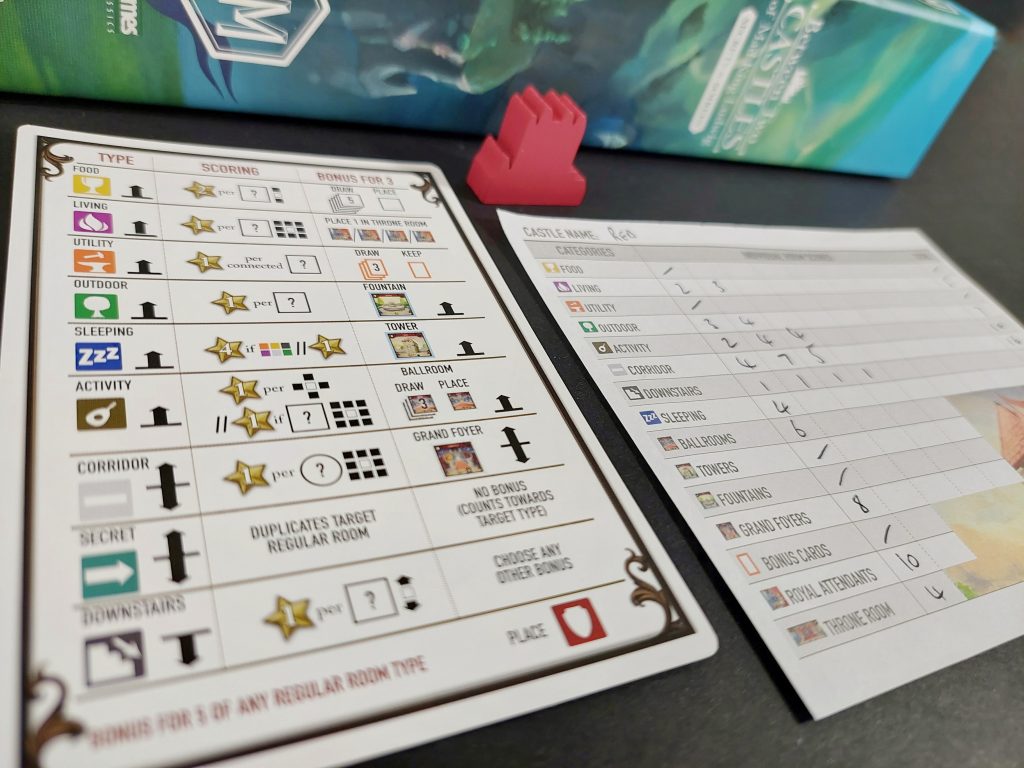
Final Thoughts On… The Secrets & Soirees Expansion
One thing I won’t activate with this expansion is the option to play it as an eight-player game. That’s not necessary. Why? Practicality. Between Two Castles… is a table hog, due to the unpredictable nature in which the layouts sprawl. You struggle to play this – comfortably – on a standard rectangular table at six players. Trying to squeeze in two more players? Who has a table large enough for that?
Overall, I enjoy the new room types; they both introduce neat new ways to strategise. Of the two, the Secret Rooms are my favourite. It’s great that you can fit all this into the base game box. (This does leave me somewhat forlorn though, because the Schloss Neuschwanstein box art is gorgeous.) The Mad King’s Demand variant offers pure competitiveness, driving the series in a new direction. This will please certain fans. I don’t mind it, but I prefer the OG ‘Between’ approach. When boiled down, it interests me a lot more from a strategy and mechanisms perspective. Having a solo option is nigh-mandatory for a Stonemaier release. It’s great that this option is now present, but it surprised me this wasn’t in the base game.
I can’t, hand-on-heart, say this is an ‘essential’ expansion. (In the same way I absolutely would insist that Viticulture’s Tuscany is, for example.) It’s pleasing. It’s nice. It’s a classic 7/10. (I rated the base game 8/10, for context.) The production quality is splendid, as we’ve come to expect. This will sing to Stonemaier fans’ hearts. I’ll never play the base game again without this expansion, to be fair. The problem is I don’t feel it adds quite enough new ‘mad’ into the mix for my liking, to truly call itself a must-have.

